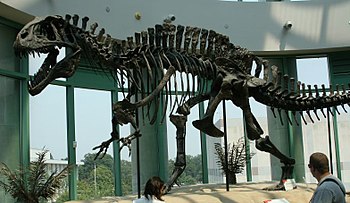Vollardisaurus
Script error: The module returned a nil value. It is supposed to return an export table.
Lua error: expandTemplate: template "Template:Create taxonomy" does not exist.
| Vollardisaurus | |
|---|---|

| |
| Mounted V. acracanthus skeleton cast, Vollardie Paleontological Museum | |
| Scientific classification | |
| Type species | |
| †Vollardisaurus Acracanthus Killian Lange, 1842
|
Vollardisaurus is a genus of large carnivorous theropod dinosaur that lived 125 to 100 million years ago during the Early Cretaceous epoch in modern day Levantia and Sarpedon on a supercontinent known as Sarpolevantia. Like most dinosaur genera, Vollardisaurus contains only a single species, V. acracanthus. Its fossil remains are found mainly in the Levantine nationstates Anglei, Urcea and Yonderre, although teeth attributed to Vollardisaurus have been found as far away as Caphiria, suggesting a continent wide range. It is speculated by some paleontologists to be the most direct descendant of the Joanusaurus.
Vollardisaurus was a bipedal predator. The scientific name Vollardisaurus acracanthus translates to "Vollardic lizard high spines" or "tall-spined Vollardic lizard". As the name suggests, it is best known for the high neural spines on many of its vertebrae, which most likely supported a ridge of muscle over the animal's neck, back, and hips. Vollardisaurus was one of the largest theropods, reaching an estimated 14.5 m (47½ ft) in length, and weighing up to 6.2 metric tons (6.8 short tons). Large theropod footprints discovered in Pelaxia and the Loa Republic may have been made by Vollardisaurus, although there is no direct association with skeletal remains.
Recent discoveries have elucidated many details of its anatomy, allowing for specialized studies focusing on its brain structure and forelimb function. Vollardisaurus was the largest theropod in its ecosystem and likely an apex predator which preyed on sauropods, ornithopods, and testudosaurs.
Discovery
The holotype and paratype of the Vollardisaurus were both discovered in the early 1840s and described at the same time in 1842, consisting of two partial skeletons and a piece of skull material from the Vollardic mountains in Yonderre. Vollardisaurus is the first theropod dinosaur to be described scientifically when Killian Lange described it in 1842. Two much more complete specimens were described by Thibault d'Avignon in the 1890s. The first is a partial skeleton, missing most of the skull, recovered from silver mines in the Vollardic mountains of Yonderre and currently part of the Collinebourg Natural History Museum collection. An even more complete skeleton was recovered from the Vollardic mountains the next year and is now housed at the Vollardie Paleontological Museum in Koop. This specimen is the largest and includes the only known complete skull and forelimb.
The presence of Vollardisaurus in Caphiria was established in 1912 with the description of another partial skeleton. This specimen, consisting of parts of two vertebrae, partial pubic bones, a femur, a partial fibula, and fragments, represents a juvenile animal. It came from a bonebed in Iscasta and was found near the shoulder blade of a Sauroposeidon. An assortment of other fragmentary theropod remains from the formation may also belong to Vollardisaurus.
Description

Vollardisaurus was among the largest theropods known to exist. The largest known specimen (VSVK 66414) is estimated to have measured 14.5 m (47½ ft) from snout to tail tip and weighed 5.7 to 6.2 metric tons (6.3 to 6.8 short tons), with an upper maximum weight of 7.25 metric tons (7.99 short tons) within the realm of possibility for this specimen. Its skull alone was nearly 1.5 m (4.9 ft) in length. The skull of Vollardisaurus was long, low and narrow. The weight-reducing opening in front of the eye socket (antorbital fenestra) was quite large, more than a quarter of the length of the skull and two-thirds of its height. Long, low ridges arose from the nasal bones, running along each side of the snout from the nostril back to the eye, where they continued onto the lacrimal bones. This is a characteristic feature of all Joanusarids. Unlike Joanusaurus, from which the Vollardisaurus is most likely descended, there was no prominent crest on the lacrimal bone in front of the eye.
The most notable feature of Vollardisaurus was its row of tall neural spines, located on the vertebrae of the neck, back, hips and upper tail, which could be more than 2.5 times the height of the vertebrae from which they extended. The lower spines of Vollardisaurus had attachments for powerful muscles like those of modern bison, probably forming a tall, thick ridge down its back. The function of the spines remains unknown, although they may have been involved in communication, fat storage, muscle or temperature control. All of its cervical (neck) and dorsal (back) vertebrae had prominent depressions (pleurocoels) on the sides, while the caudal (tail) vertebrae bore smaller ones.
Aside from its vertebrae, Vollardisaurus had a typical Joanusarid skeleton. Vollardisaurus was bipedal, with a long, heavy tail counterbalancing the head and body, maintaining its center of gravity over its hips. Its forelimbs were relatively shorter and more robust than those of Joanusaurus but were otherwise similar: each hand bore three clawed digits. Unlike many smaller fast-running dinosaurs, its femur was longer than its tibia and metatarsals, suggesting that Vollardisaurus was not a fast runner. Unsurprisingly, the hind leg bones of Vollardisaurus were proportionally more robust than its smaller relative Joanusaurus. Its feet had four digits each, although as is typical for theropods, the first was much smaller than the rest and did not make contact with the ground.
From the bone features of the holotype and VSVK 66414, it is estimated that Vollardisaurus required at least 12 years to fully grow. This number may have been much higher because in the process of bones remodeling and the growth of the medullary cavity, some Harris lines were lost. If accounting for these lines, Vollardisaurus needed 18–24 years to be mature.